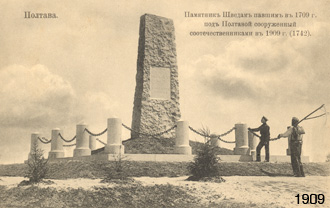|
 The proposal to erect a monument on the battlefield to commemorate
the Swedish warriors who had lost their lives there was raised first in
1890 by then Major Claus Grill. As a participant in the Russian-Swedish military
exchange program, he had often been to Poltava and the battlefield.
In an article published in 1902 he made an
appeal to the public for donations. Although his idea to erect a monument
to the soldiers who had fought so valiantly under Charles XII was welcomed
by HM King Oscar II, it also triggered fierce debates in the press.
While one group considered the idea to be shameful,
others appealed for Christian mercy contending that
fallen soldiers deserve a cross to be installed upon their
last resting place regardless of their nationality. By this time
a famous Swedish sculptor,
Theodor Lundberg,
had completed a model of the monument and submitted
it to the public. This monument represented a
Swedish mother using a Swedish flag to cover her fallen son
who is still holding a broken sword. The sign on the monument's foundation
stated: "To our fallen sons from the motherland". Lundberg's project was approved by
high ranking authorities but for a different location. Instead of being erected on the
battlefield, it was placed in front of the Swedish Army Museum. The monument
was unveiled on November 6th 1904 in the presence of HM King Oscar II.
The proposal to erect a monument on the battlefield to commemorate
the Swedish warriors who had lost their lives there was raised first in
1890 by then Major Claus Grill. As a participant in the Russian-Swedish military
exchange program, he had often been to Poltava and the battlefield.
In an article published in 1902 he made an
appeal to the public for donations. Although his idea to erect a monument
to the soldiers who had fought so valiantly under Charles XII was welcomed
by HM King Oscar II, it also triggered fierce debates in the press.
While one group considered the idea to be shameful,
others appealed for Christian mercy contending that
fallen soldiers deserve a cross to be installed upon their
last resting place regardless of their nationality. By this time
a famous Swedish sculptor,
Theodor Lundberg,
had completed a model of the monument and submitted
it to the public. This monument represented a
Swedish mother using a Swedish flag to cover her fallen son
who is still holding a broken sword. The sign on the monument's foundation
stated: "To our fallen sons from the motherland". Lundberg's project was approved by
high ranking authorities but for a different location. Instead of being erected on the
battlefield, it was placed in front of the Swedish Army Museum. The monument
was unveiled on November 6th 1904 in the presence of HM King Oscar II.
Soon after the dedication of the first monument, 5,000 Swedish crowns were collected
from citizens throughout the country for a big granite stone (6 m height, 20 ton weight)
from the Vonevik quarry in Smoland. The following inscription was carved
on the stone in both Russian and Swedish: "This stone was erected in 1909
in honor of the Swedes who perished in 1709 by their compatriots." The Swedish
businessman
Emmanuel Nobel,
a relative of Alfred Nobel, the inventor of dynamite, assumed financial responsibility
for the delivery and installation of the
monument. The memorial stone was unveiled on June 2nd 1909 close to the
hamlet of Pobyvanka without any public ceremony. A small article dedicated
to the event was published on July 7th 1909 in
the Swedish newspaper "Stockholm News."
|
 History
History
 Dates and events
Dates and events
 Persons
Persons
 Poltava
Poltava
 Sights
Sights
 Photo gallery
Photo gallery
 Maps
Maps
 Virtual Museum
Virtual Museum
 Armament
Armament
 Uniforms
Uniforms
 Coins and medals
Coins and medals
 Flags
Flags
 Paintings
Paintings
 Poltava photographs
Poltava photographs
 News
News
 About us
About us
 Acknowledgments
Acknowledgments
 Main page
Main page
 Photo gallery
Photo gallery
 top
top ...back
...back  The proposal to erect a monument on the battlefield to commemorate
the Swedish warriors who had lost their lives there was raised first in
1890 by then Major Claus Grill. As a participant in the Russian-Swedish military
exchange program, he had often been to Poltava and the battlefield.
In an article published in 1902 he made an
appeal to the public for donations. Although his idea to erect a monument
to the soldiers who had fought so valiantly under Charles XII was welcomed
by HM King Oscar II, it also triggered fierce debates in the press.
While one group considered the idea to be shameful,
others appealed for Christian mercy contending that
fallen soldiers deserve a cross to be installed upon their
last resting place regardless of their nationality. By this time
a famous Swedish sculptor,
The proposal to erect a monument on the battlefield to commemorate
the Swedish warriors who had lost their lives there was raised first in
1890 by then Major Claus Grill. As a participant in the Russian-Swedish military
exchange program, he had often been to Poltava and the battlefield.
In an article published in 1902 he made an
appeal to the public for donations. Although his idea to erect a monument
to the soldiers who had fought so valiantly under Charles XII was welcomed
by HM King Oscar II, it also triggered fierce debates in the press.
While one group considered the idea to be shameful,
others appealed for Christian mercy contending that
fallen soldiers deserve a cross to be installed upon their
last resting place regardless of their nationality. By this time
a famous Swedish sculptor,